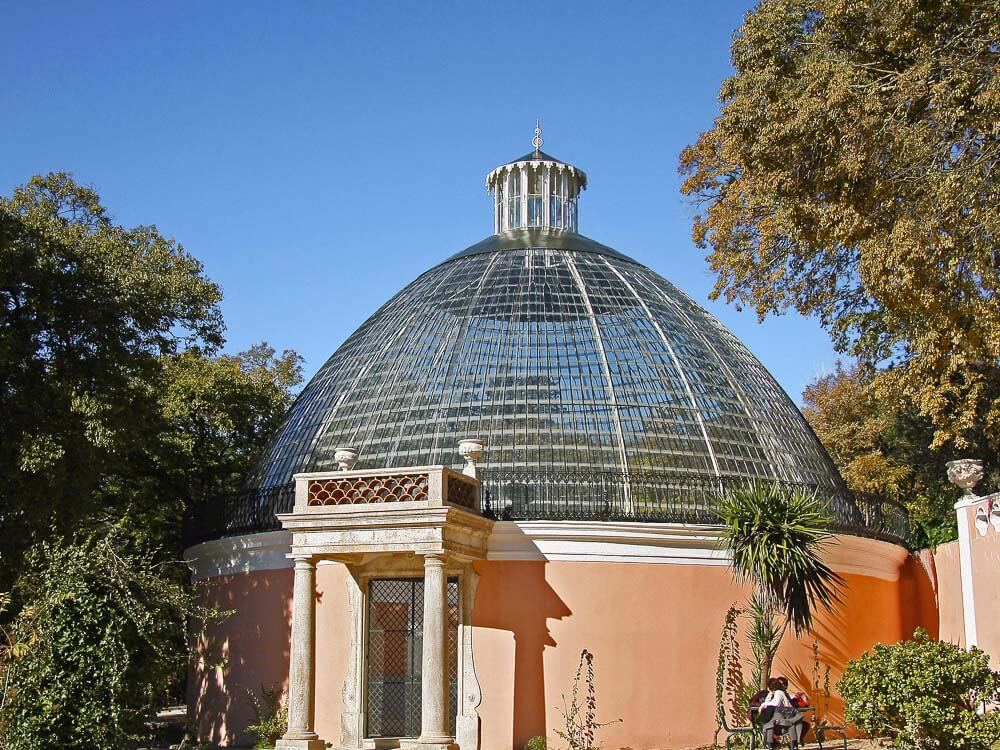Located along the Tagus River, Santos, or Santos-o-Velho, is one of Lisbon’s oldest neighborhoods. Known for its antique shops, art galleries and streets lined with cafés and restaurants, Santos offers a quieter experience compared to more tourist areas, such as the nearby Bairro Alto and Baixa-Chiado.
With a welcoming atmosphere and great location for exploring historical sites, I’d say Santos is one of the best places to have an authentic Lisbon experience away from large crowds. So, if that seems like something you’d like, this guide should be very useful!
Today, I’ll tell you all about Santos, including the best things to do there, where to eat and where to stay. Get ready to fall in love with another one of Lisbon’s great neighborhoods!
Index

1. What to see and do in Santos?
Santos is very close to other tourist neighborhoods in Lisbon, which means it’s easy to get to attractions such as Rossio Square and Santa Justa Lift front here. However, there are also a couple of great attractions located in Santos itself. Here are the main ones:
1.1. National Museum of Ancient Art (Museu Nacional de Arte Antiga)

The National Museum of Ancient Art, also known as Museu das Janelas Verdes, opened in 1884 and is housed in a rather simple building, decorated only with Baroque doorways, which conceals the greatness found inside.
But don’t let the plain façade fool you. To this day, this is one of the most important museums in Portugal, with a great variety and depth of artworks that provide insights into artistic progress over time.
The museum’s impressive collection of over 40,000 items includes a wide range of Portuguese and European artworks, including paintings and sculptures, as well as silverware and decorative arts.
1.2. Igreja de São Francisco de Paula

The Igreja de São Francisco de Paula was originally a hospice before becoming a convent in 1719, and is one of the few buildings that survived the 1755 earthquake. Located near the National Museum of Ancient Art, the church may not be as popular as other landmarks, but it’s definitely worth visiting.
It showcases a mix of Baroque and Neoclassical styles, and among its highlights are the tomb of Queen Mariana Vitória, a ceiling painting depicting St. Francis of Paola’s vision of Michael the Archangel and artworks by Vieira Lusitano. It offers free admission, and is an essential stop for art, history and architecture lovers.
1.3. Chafariz das Janelas Verdes

The Chafariz das Janelas Verdes, or Janelas Verdes Fountain, is located in the Santos neighborhood at Largo Dr. José de Figueiredo, near the Museum of Ancient Art.
Designed by Reinaldo Manuel dos Santos, the fountain was constructed from pink and white marble in a circular layout, and connects directly to the Águas Livres Aqueduct.
Its ground level includes two tanks originally designed for animals, and above them is a larger circular tank topped with a detailed sculptural ensemble by António Machado. It’s truly a remarkable artistic piece that you just have to visit while in Santos!
1.4. Cemitério dos Prazeres

Cemitério dos Prazeres (Prazeres Cemetery) dates back to the cholera epidemic of 1833, and to this day still functions as a burial ground. There, you’ll find monuments made by well-known sculptors as well as simple, unmarked graves, all of them telling a piece of Lisbon’s history.
The cemetery offers guided tours that take visitors on a journey through the architectural wonders and the lives of all who are buried there, as well as the cypress trees that surround the grounds. Overall, it’s a very beautiful and peaceful place that is worth a visit.
For more information, check out my post about Cemitério dos Prazeres!
1.5. Basílica da Estrela

The Basílica da Estrela is an 18th century neoclassical monument located in Santos, Lisbon. It was built by order of Queen Maria after her son was born, as she had promised to do so if she had an heir.
Among its most prominent features are the rococo elements, such as the detailed dome and twin bell towers, the statues of saints and allegorical figures along the façade and the contrasting pink and black marble found inside the basilica.
There, you’ll also be able to see the tomb of Queen Maria, and a Christmas manger displayed throughout the year with over 500 figures depicting community life during biblical times. Additionally, you can climb to the dome for some incredible city views, which I recommend!
1.6. Tapada das Necessidades

Tapada das Necessidades is a large public park in Santos, located between Prazeres Cemetery and the Tagus River. Previously, it was part of the Royal Palace of Necessidades grounds, but now serves as a quiet space away from the city center for both locals and visitors to relax.
The park contains several abandoned pastel-colored buildings, and the paths are slightly overgrown. It may be a bit neglected, but that’s part of its charm and why it’s very popular for picnics and walks under the trees.
Tapada das Necessidades offers a very peaceful environment that mixes nature and history, making it ideal for those seeking a short respite from city life.
1.7. Jardim da Estrela

Jardim da Estrela, also known as Guerra Junqueiro Garden, is a green space in Santos, Lisbon, that covers approximately 4.6 hectares and is styled after an English garden with romantic elements.
The garden offers a peaceful setting, perfect for quiet moments amidst nature, as well as walks and other outdoor activities. It contains a central lake with well-kept flower beds around it, and a café so that visitors can relax while enjoying a beverage.
It opens at 7AM and closes at midnight, providing ample time for both locals and tourists to enjoy some peace and quiet in the middle of the city.
1.8. Museu da Carris

The Museu da Carris highlights the history of Lisbon’s main transportation line, active since 1872. More than a simple archive, this museum actively reflects on how public transport has evolved and holds a variety of historical objects important to urban mobility.
There, you’ll be able to explore a collection that includes documents, photographs, uniforms, and tickets. Each of these pieces contributes to understanding how transportation has influenced both the physical and social aspects of Lisbon across different times.
The museum sheds light on technical progress and shifts in public transport services. One of the coolest features is the display of old trams and buses, some from their initial years of service, which were carefully restored to preserve their original state.
1.9. Museu da Marioneta

Opened in 2001, the Museu da Marioneta is Portugal’s first national museum dedicated to marionettes. While its main focus is on Portuguese puppet history, the museum’s wide collection includes not only traditional Portuguese puppets, but also marionettes and masks from around the world.
Besides the permanent exhibit, the Museu da Marioneta also hosts regular puppet shows and animated plays, making it a great culturally engaging visit for families with children. But trust me when I say that it’s a very cool experience for all ages! It’s truly amazing to see how puppetry has been employed worldwide for storytelling.
3. How to get to Santos?
Santos is conveniently located between the historic center and Belém. While there’s no metro station, the Lisbon-Cascais train line serves the area, as well as buses and trams like Tram 25 and bus 714, which run directly from downtown Lisbon’s Praça da Figueira to Santos.
It’s also easy to reach the neighborhood by walking. From Estrela, for example, it takes only 2 minutes to reach Santos, while Cais do Sodré is a 10-minute walk away.
4. Where to stay in Santos?
One of the best things about Santos is that, despite being close to the historic center, it’s a quiet, more residential neighborhood. This means it not only offers convenient access to tourist attractions, but also a peaceful environment away from crowds. It’s the best of both worlds!
So, if you’re looking for a place to stay there, here are my main hotel recommendations in Santos:
- JAM Lisbon: a 3-star hotel that features an outdoor pool, terrace, bar, nightclub, and business center. The on-site restaurant serves African, Brazilian, and Portuguese cuisine, including vegetarian, vegan, and gluten-free options.
- The Emerald House Lisbon: a 4-star hotel that provides access to a fitness center, restaurant, and bar, offering convenience with room service and 24-hour front desk support. Guests can enjoy buffet or continental breakfast options daily.
- As Janelas Verdes: situated next to the Ancient Art Museum in an updated 18th-century building, conveniently located near Santos Train Station, this hotel offers classic Portuguese décor. Its rooftop library with a fireplace and terrace provides river views.
- Palácio Ramalhete: a hotel that blends historical elements with modern comforts in an old palace close to the Museum of Ancient Art. Rooms include antique furniture, wooden floors, and authentic ceramic tiles, with views over the Tagus River. It also offers a breakfast buffet, outdoor lounge area, bar, and heated pool.
5. History of santos

Santos, known as the design district of Lisbon, has a rich history that blends with its contemporary development. In the 16th century, it was an aristocratic area, filled with mansions and wealthy residents, and, by the 18th century, Santos had transitioned into an industrial center.
Despite facing decline in the 20th century, the neighborhood experienced a revival in the early 21st century, which restored its historic architecture and added new residential and commercial spaces. Besides that, the public transport system was improved, making it easier to reach via bus, tram and train.
Nowadays, Santos is known for its tightly-knit community and welcoming vibe, as well as for its lively nightlife and renowned design and architecture schools. It’s an ideal place to enjoy coffee and pastries from local bakeries, soaking in the calm atmosphere.
6. Architecture in santos
Santos was known for its large mansions similar to those in the Lapa district, historically occupied by aristocrats and noble families in the 18th century. Now, many of these mansions serve as hotels and embassies, most of which are located on streets like Rua do Sacramento à Lapa and Rua das Janelas Verdes.
Besides that, former industrial warehouses in Santos have been converted into centers for creative and cultural activities, hosting a variety of businesses from art galleries to design studios, revitalizing former utilitarian spaces.
With this mix of traditional architecture and modern projects, Santos is a significant neighborhood not only for its history but also for its role in the arts and culture scene in Lisbon.
Experience the essence of Lisbon in Santos!

Santos is a quiet, laid-back neighborhood that encapsulates a more modern side of Lisbon, while still retaining its historical roots and stunning 18th century architecture. And, while it’s not as touristy as other areas, it offers easy access to a lot of attractions, both in Santos itself and in nearby neighborhoods.
It’s a place that allows visitors to experience a more peaceful atmosphere and get a taste of the local lifestyle, perfect for enjoying an afternoon in one of the many cafés, visiting museums or even going for a night out.
If you want to see a different side of Lisbon, then Santos is a neighborhood I highly recommend that you visit at least once!







